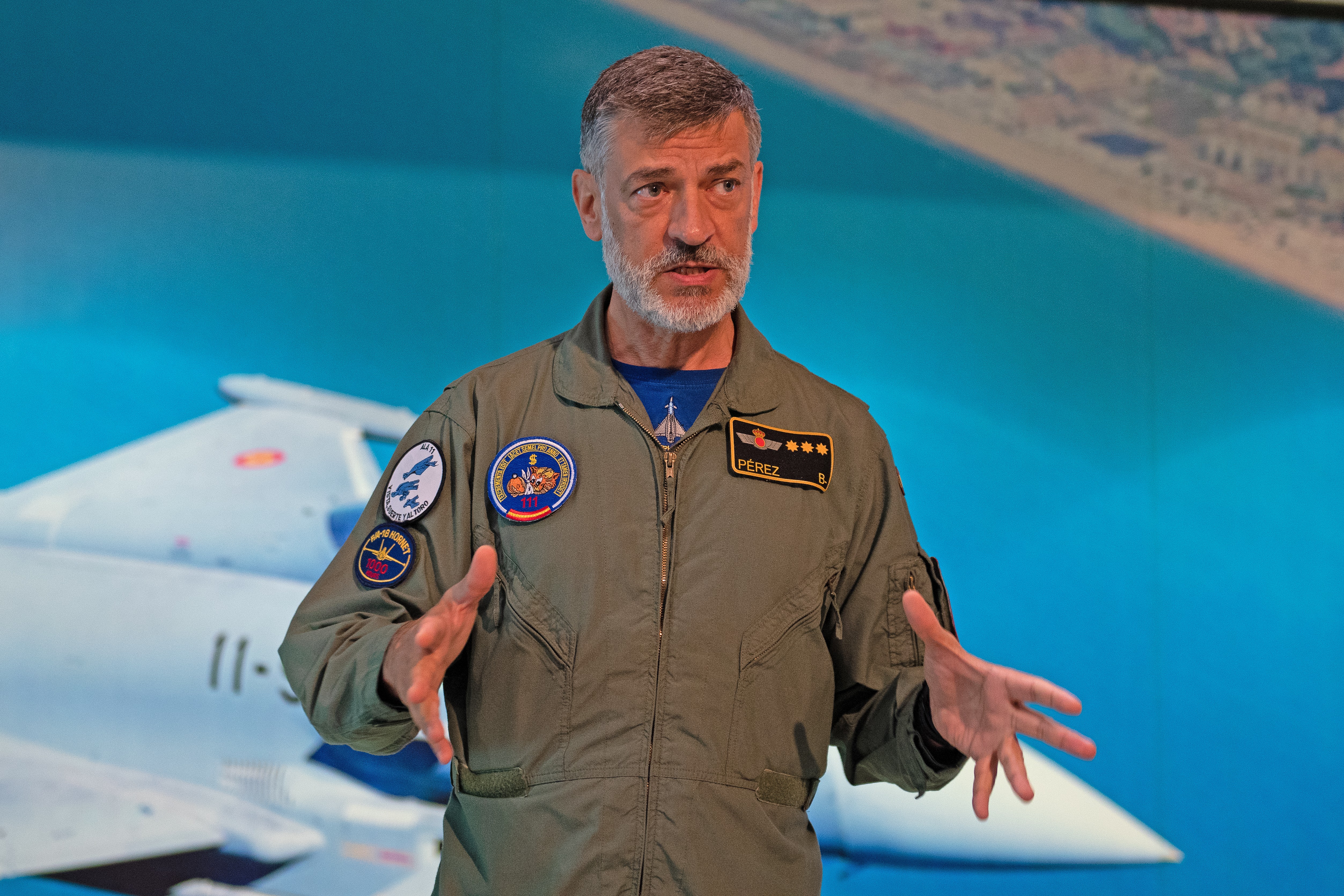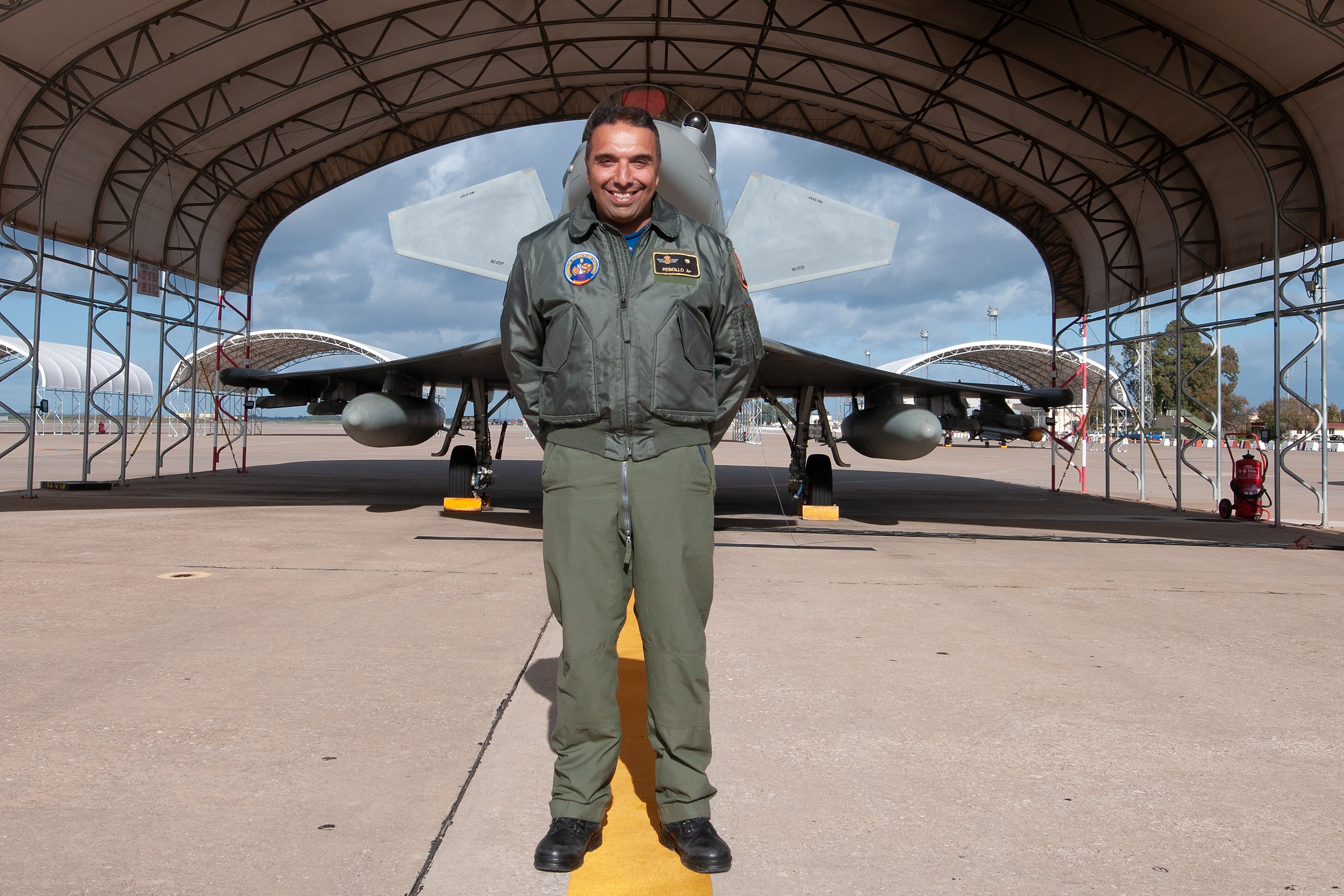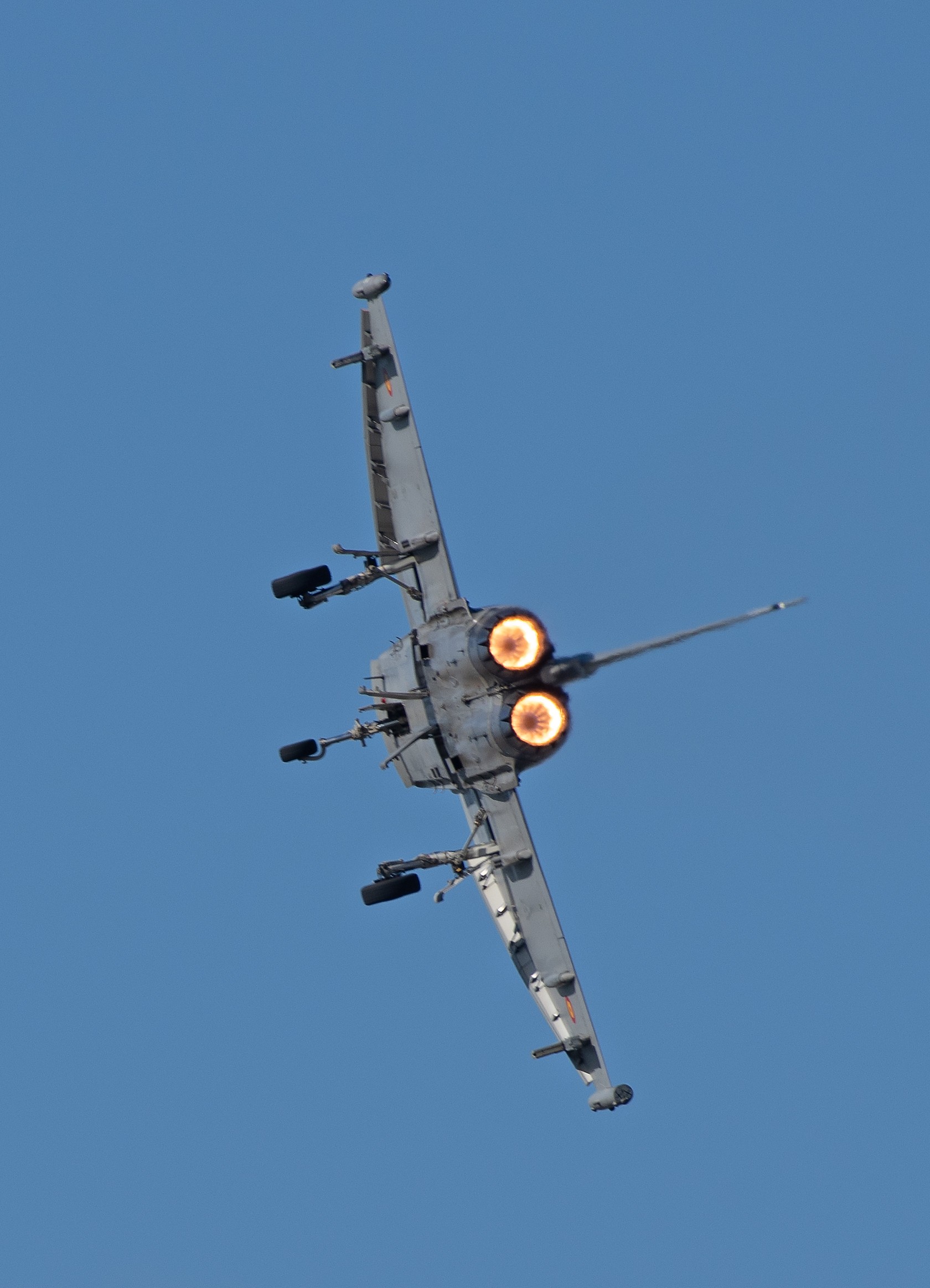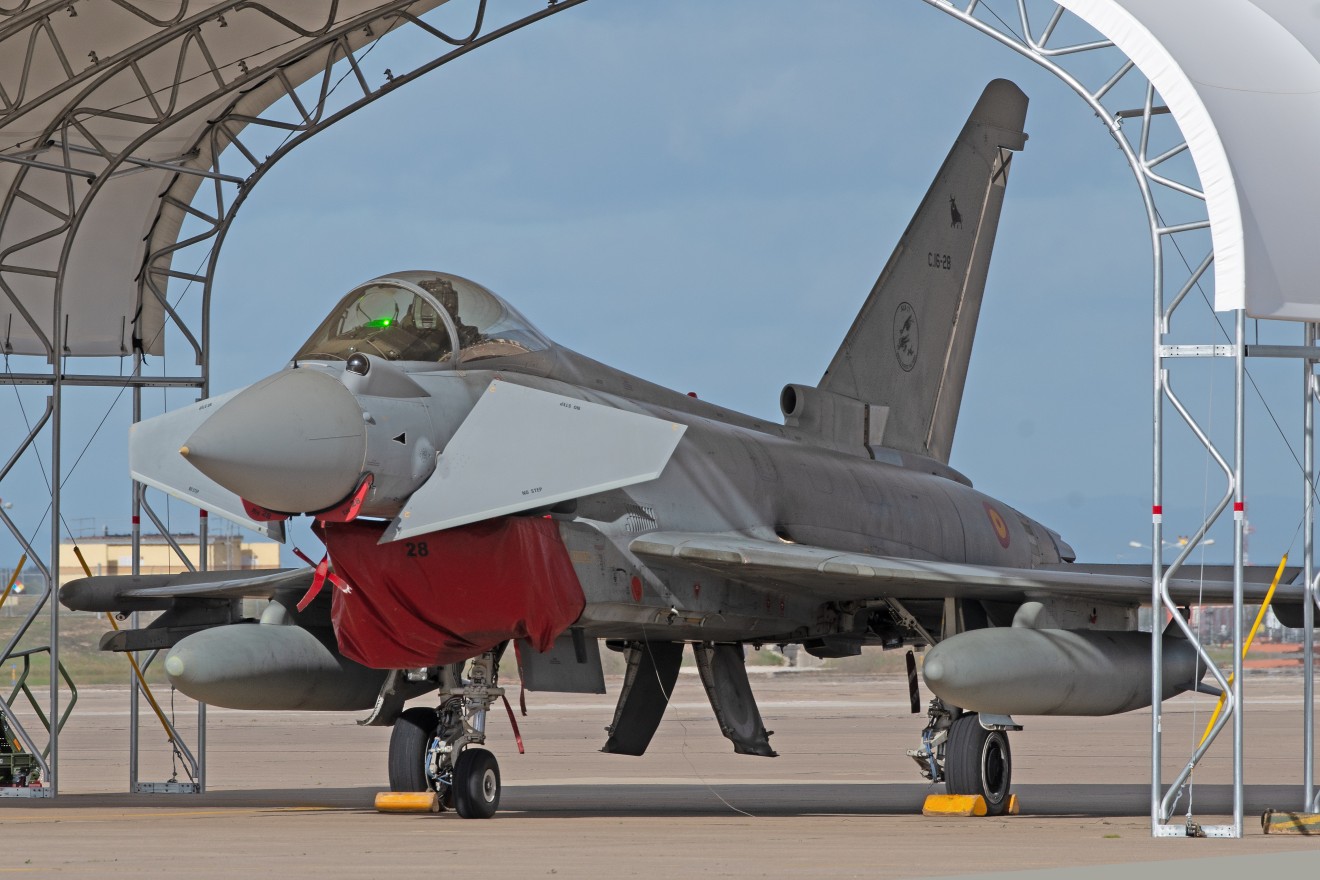Take-off is the attention grabber. Noise and a physics-defying vertical climb!
Then, for the next 15 minutes we’re treated to an eardrum-shattering display that emphasises Eurofighter’s incredible power and agility and the pilot’s nerveless skill. It’s a balletic sequence of rolls, dives, climbs, loops, and slow, low passes.
Back in the warmth of the training centre the pride in the Eurofighter is clear for all to see. One entire wall features a picture of the jet in flight over a crystal blue ocean, while over the balcony there’s a huge Spanish flag.
At Morón you’re left in no doubt what people think about the aircraft nor what Eurofighter means to the Spanish Air Force. Base Commander Colonel Carlos Perez Martinez is unequivocal: “For Spain, Eurofighter represents a huge positive in two main ways. First, from an industry point of view, we have been able to develop a robust aeronautical industry, and that in turn has provided us with technological independence.
“The decision Spain took to be part of the Eurofighter programme was a turning point in our industrial history.
"Eurofighter has been the catalyst for a lot of companies — companies like Indra (now Airbus) who have a presence at Morón Air Base. Today, it’s one of the biggest technology companies in Spain and there are many others who have benefited from being part of the Eurofighter programme.

Base Commander Colonel Carlos Perez Martinez
“The second effect for Spain is that Eurofighter represents a smooth, logical transition for the Spanish Air Force from the F18 to a much more advanced aircraft. For us in the Air Force the aircraft represents combat readiness. It has high availability, it’s reliable, and, of course, it’s very capable. Moving from the F18 to Eurofighter was such a natural path. The Eurofighter does everything its predecessor did but is more powerful, more robust, has more powerful sensors and more capability. Everything about it is superior.
“It also provides us with interoperability with several other air forces across Europe. So if we go on exercises we find the same spare parts, same support equipment and same aircraft. It’s an aircraft that was built and developed 100 per cent to NATO standards which underscores its inter-operability.”
Colonel Martinez says another key advantage of being part of the Eurofighter family is that Spain has direct influence over how the programme develops.
With Eurofighter we are the owners of the aircraft and we have control. There are no black boxes
“With Eurofighter we are the owners of the aircraft and we have control. There are no black boxes — everything in the aircraft is managed by the Spanish Air Force. It means we develop what we want, and we have full capability over the developing software, the improvements we want, and we have a real say in how the aircraft will evolve.
Morón is home to the 11th Fighter Wing, the operational squadron which is a multi-role air defence and attack squadron — meaning it’s capable of conducting both air defence and strike missions, or both in the same mission.
“This is our job. It’s what drives our training on a daily basis and it’s what drives our participation in exercises,” explains Major Rafael ‘Rafon’ Sanz Rebollo, the 111 Sqn Commander.

Major Rafael ‘Rafon’ Sanz Rebollo
“As part of our role we have jets prepared on base 24/7 every day of the year on Quick Reaction Alert [QRA]. The aircraft are ready to take off at all times in order to safeguard our air space.
“From an operator’s perspective Eurofighter is specially built for that mission, because the start-up procedures are very, very fast. We are able to get airborne much faster than the NATO requirement — we just start the engines and everything’s good to go. Our role will sometimes require us to quickly intercept or identify other aircraft and Eurofighter is ideal for the job. It’s capable of reaching altitudes of over 50,000 feet in less than two minutes.
“And it has a great future. This weapon system is designed for constant evolution and enhancement. The enhancements will change the capabilities of the aircraft and expand its potential.”
Says Rafon: “We became part of the NATO Response Force in 2015 which was a major milestone for the Spanish Air Force. Today, we are constantly part of NATO reaction forces and national reaction forces. We take part in NATO drills and one of the most important missions right now is to safeguard the air space in those nations that don’t have the capability to safeguard the air space themselves, because they don’t have a fighter fleet.
“A Spanish Eurofighter unit has been part of NATO’s multi-air policing mission every year and will continue to do so in the future.”
Indeed, Spain deployed a unit to the Baltics during the summer of 2018. “We decided to do a little bit more during that mission. We took six jets over and carried out a lot of training flights with other nations and we did it all using what we call the ‘bare-base concept’. In essence that means we didn’t deploy to a fixed infrastructure but instead we went over to a runway out of Šiauliai Air Base in Lithuania. We deployed with our own infrastructure, with our own material and with our own squadron on a very limited footprint. It was very challenging.”
During the deployment the ground crew built temporary shelters and had a small container city of spares and equipment to service and maintain the aircraft. They had two aircraft on QRA and carried out a lot of different training exercises. And incredibly, despite the conditions and the volume of activity, the unit still managed to achieve daily availability for all QRA activity of 97 per cent.
For Rafon, Eurofighter can be summed up in one word: Europe. “We are co-operating in so many aspects nowadays. We share the same currency, we have the same foreign affairs. We are trying to develop around capability and that’s true in terms of technology and aviation. Having the possibility to develop both software and hardware and to tailor the platform to our requirements — to our national requirements — is a must.”
He says that a good example of how interoperability is growing within Europe is the presence of exchange pilots in different air forces.
“Earlier in my career I had a chance to become an exchange pilot, but the difference then was that we had to learn to fly a different aircraft. It took too long for us to adapt to it, to the tactics and the procedures,” says Rafon.
“But today we are hosting an exchange pilot from the German Air Force and at the same time there’s a Spanish pilot in a German squadron and they’re both familiar with Eurofighter.

“That’s a huge difference when it comes to interoperability and with so many different nations flying Eurofighter it gives us the possibility to grab a flight bag, show up at a different base and fly exactly the same aircraft with the same software versions, and there is no need to convert to a different weapon system. That’s a huge advantage.
“Eurofighter provides us with the highest level of combat readiness in the world.
"And because we have more than 500 Eurofighters in Europe over several nations all operating the same aircraft it provides us with obvious inter-operability amongst us.”
The demands on the 111 Sqn are heavy and key to their pilots being able to deliver to the highest level is ensuring they have the right training. The air base at Morón boasts one of the finest training centres in Europe.
The centre consists of four devices including cockpit trainers and full mission simulators and one part ex trainer. Says Major Barranco: “These four devices give us the opportunity to carry out both basic training and some advanced training by connecting them in network. We also have the capability with our database to generate on demand any scenario from all over the world.”
Major Barranco: “These four devices give us the opportunity to carry out both basic training and some advanced training by connecting them in network. We also have the capability with our database to generate on demand any scenario from all over the world.”
98% Mission Availability
The Eurofighter’s characteristic ease of maintenance was underlined by the Technical Group Commander, Lieutenant Colonel Jose Enrique Hernandez Medel, in charge of maintenance at Moron.
He said: “Eurofighter is far more reliable and easier to maintain than other aircraft I’ve worked with during my career. When I think of other aircraft you have to deal with a host of different issues — maybe the fuselage, or a fuel leak or a gear box problem. Complications like these can take weeks or months to deal with. Eurofighter is completely different.
“Yes, we do get issues, but they tend to be ones that are easily resolved and are more to do with the sensitivity of the equipment. I think you can sum it up like this — when I think about going into work with other aircraft it was a case of ‘oh dear’, but with Eurofighter it’s ‘wow, fantastic.’
“You can see that ease of upkeep and reliability factor play out during deployments. Last year we were able to operate with mission availability of 97-98%, which from a maintenance perspective is excellent.”
